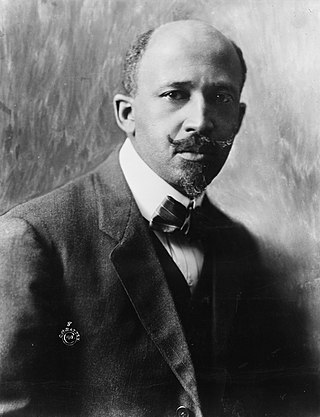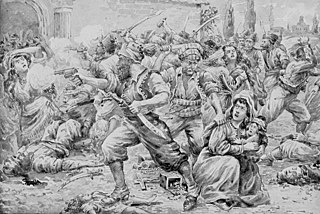
Genocide is the intentional destruction of a people in whole or in part.

Cultural genocide or culturicide is a concept described by Polish lawyer Raphael Lemkin in 1944, in the same book that coined the term genocide. The destruction of culture was a central component in Lemkin's formulation of genocide. Though the precise definition of cultural genocide remains contested, the Armenian Genocide Museum defines it as "acts and measures undertaken to destroy nations' or ethnic groups' culture through spiritual, national, and cultural destruction". The drafters of the 1948 Genocide Convention initially considered using the term, but later dropped it from inclusion.

Ethnic cleansing is the systematic forced removal of ethnic, racial, or religious groups from a given area, with the intent of making a region ethnically homogeneous. Along with direct removal such as deportation or population transfer, it also includes indirect methods aimed at forced migration by coercing the victim group to flee and preventing its return, such as murder, rape, and property destruction. Both the definition and charge of ethnic cleansing is often disputed, with some researchers including and others excluding coercive assimilation or mass killings as a means of depopulating an area of a particular group.
The Convention on the Prevention and Punishment of the Crime of Genocide (CPPCG), or the Genocide Convention, is an international treaty that criminalizes genocide and obligates state parties to pursue the enforcement of its prohibition. It was the first legal instrument to codify genocide as a crime, and the first human rights treaty unanimously adopted by the United Nations General Assembly, on 9 December 1948, during the third session of the United Nations General Assembly. The Convention entered into force on 12 January 1951 and has 152 state parties as of 2022.

Raphael Lemkin was a Polish lawyer of Jewish descent who is known for coining the term genocide and campaigning to establish the Genocide Convention. During the Second World War, he campaigned vigorously to raise international outrage against atrocities in Axis-occupied Europe. It was during this time that Lemkin coined the term "genocide" to describe Nazi Germany's extermination policies against Jews and Poles.

Forced assimilation is the involuntary cultural assimilation of religious or ethnic inferior groups, during which they are forced by a government to adopt the language, national identity, norms, mores, customs, traditions, values, mentality, perceptions, way of life, and often the religion and ideology of an established and generally larger community belonging to a dominant culture.

We Charge Genocide is a paper accusing the United States government of genocide based on the UN Genocide Convention. This paper was written by the Civil Rights Congress (CRC) and presented to the United Nations at meetings in Paris in December 1951.

The Greek genocide, which included the Pontic genocide, was the systematic killing of the Christian Ottoman Greek population of Anatolia which was carried out mainly during World War I and its aftermath (1914–1922) on the basis of their religion and ethnicity. It was perpetrated by the government of the Ottoman Empire led by the Three Pashas and by the Government of the Grand National Assembly led by Mustafa Kemal Atatürk, against the indigenous Greek population of the Empire. The genocide included massacres, forced deportations involving death marches through the Syrian Desert, expulsions, summary executions, and the destruction of Eastern Orthodox cultural, historical, and religious monuments. Several hundred thousand Ottoman Greeks died during this period. Most of the refugees and survivors fled to Greece. Some, especially those in Eastern provinces, took refuge in the neighbouring Russian Empire.

Anti-Armenian sentiment, also known as anti-Armenianism and Armenophobia, is a diverse spectrum of negative feelings, dislikes, fears, aversion, racism, derision and/or prejudice towards Armenians, Armenia, and Armenian culture.
The genocide of Indigenous peoples, colonial genocide, or settler genocide is the intentional elimination of Indigenous peoples as a part of the process of colonialism.
The genocide of indigenous peoples in Brazil began with the Portuguese colonization of the Americas, when Pedro Álvares Cabral made landfall in what is now the country of Brazil in 1500. This started the process that led to the depopulation of the indigenous peoples in Brazil, because of disease and violent treatment by Portuguese settlers, and their gradual replacement with colonists from Europe and enslaved peoples from Africa. This process has been described as a genocide, and continues into the modern era with the ongoing destruction of indigenous peoples of the Amazonian region.
There are 17 indigenous tribes in Paraguay with the majority having their territories in the Chaco region. Tribes in this region include the Guaraní, Ayoreo, Toba-Maskoy, Aché and Sanapan which according to the census from 2002 number an estimated 86,000 or roughly around 2 per cent of the total population. These peoples have faced persecution particularly under the dictator Alfredo Strossner that some observers called a genocide.
Armenian–Jewish relations are complex, often due to political and historical reasons.

Genocide studies is an academic field of study that researches genocide. Genocide became a field of study in the mid-1940s, with the work of Raphael Lemkin, who coined genocide and started genocide research, and its primary subjects were the Armenian genocide and the Holocaust; the Holocaust was the primary subject matter of genocide studies, starting off as a side field of Holocaust studies, and the field received an extra impetus in the 1990s, when the Rwandan genocide occurred. It received further attraction in the 2010s through the formation of a gender field.

The relationship between the Armenian genocide and the Holocaust has been discussed by scholars. The majority of scholars believe that there is a direct causal relationship between the Armenian genocide and the Holocaust, however, some of them do not believe that there is a direct causal relationship between the two genocides.
The terminology of the Armenian genocide is different in English, Turkish, and Armenian languages and has led to political controversies around the issue of Armenian genocide denial and Armenian genocide recognition. Although the majority of historians writing in English use the word "genocide", other terms exist.

Genocide is the deliberate and systematic destruction, in whole or in part, of an ethnic, racial, religious, or national group. The term was coined in 1944 by Raphael Lemkin. It is defined in Article 2 of the Convention on the Prevention and Punishment of the Crime of Genocide (CPPCG) of 1948 as "any of the following acts committed with intent to destroy, in whole or in part, a national, ethnical, racial, or religious group, as such: killing members of the group; causing serious bodily or mental harm to members of the group; deliberately inflicting on the group's conditions of life, calculated to bring about its physical destruction in whole or in part; imposing measures intended to prevent births within the group; [and] forcibly transferring children of the group to another group."

Below is an outline of articles on the academic field of genocide studies and subjects closely and directly related to the field of genocide studies; this is not an outline of acts or events related to genocide or topics loosely or sometimes related to the field of genocide studies. The Event outlines section contains links to outlines of acts of genocide.

On 19–20 September 2023 Azerbaijan initiated a military offensive in the disputed Nagorno-Karabakh region which ended with the surrender of the self-declared Republic of Artsakh and the disbandment of its armed forces. Up until the military assault, the region was internationally recognized as part of Azerbaijan but governed and populated by ethnic Armenians.











